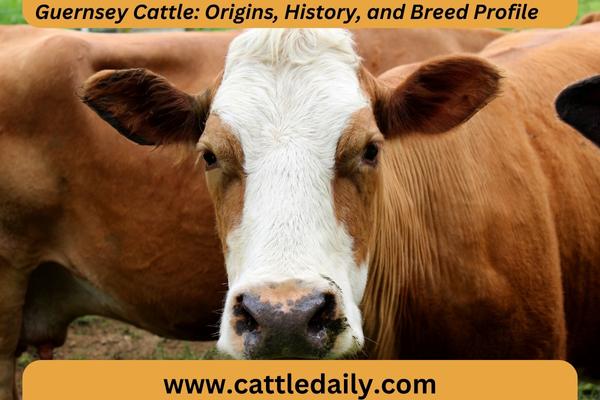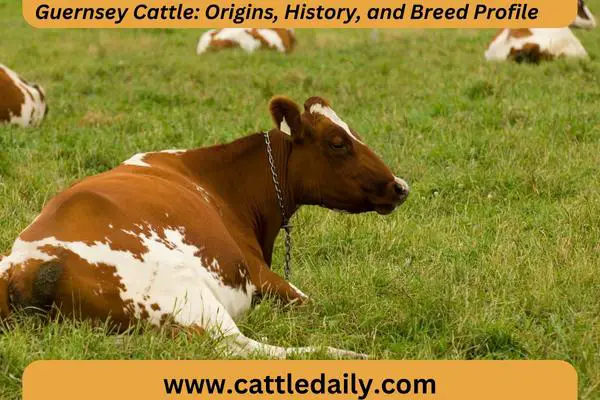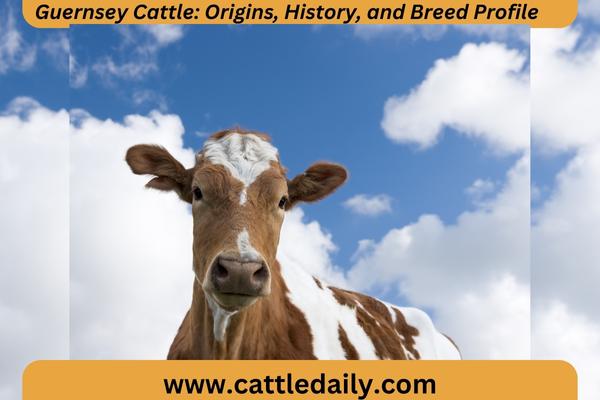Guernsey Cattle
The Guernsey is a beloved dairy cattle breed known for its rich, creamy milk and hardy disposition. With a distinctive fawn and white color pattern and docile temperament, the Guernsey cow has captivated farmers and consumers alike for generations.
Originating from the small Channel Island of Guernsey, this breed has a rich history intertwined with both the island’s heritage and economy.
Today, Guernseys can be found on dairy farms across the world, valued for their exceptional milk quality and production efficiency.
In this blog article, we’ll explore this remarkable dairy cow breed’s origins, history, characteristics, and uses.
Origins on the Isle of Guernsey
The Guernsey breed hails from the tiny, rugged island of Guernsey in the English Channel near the coast of Normandy, France. One of Britain’s Channel Islands along with Jersey, Alderney, and Sark, Guernsey is known for its mild, maritime climate influenced by the Gulf Stream.
This temperate environment made it an ideal location for grazing cattle. Guernseys are believed to be descendants of cattle brought over by settlers from nearby French coastal regions like Brittany and Normandy.
Over several centuries, these cattle adapted to the island’s varied terrain and climate, foraging on sea grasses and flowers.
Strict import and export laws enforced by the island also contributed to this cattle population remaining isolated and developing traits unique to Guernsey. By the 19th century, this pool of cattle was recognized as a distinct dairy breed called the Guernsey.
Key Events in Guernsey Breed History
Since its formation as a recognized breed in the 1800s, some pivotal moments helped shape and spread the influence of the Guernsey cow globally:
- 1814 – Guernseys are first officially imported to England and gradually introduced to other parts of the UK
- Mid to Late 1800s – Select importing and crossbreeding of Guernseys to improve desirable dairy qualities in other cattle breeds begins, starting in the UK then spreading to Australia and North America
- Early 1900s – Imports expand substantially in North America and the Guernsey breed starts gaining popularity for small farmstead cheese and butter production
- 1940s – Guernsey milk is frequently marketed for its rich flavor and golden color derived from exceptional levels of beta-carotene
- 1960s – Mechanized milking enabled further distribution to commercial dairy farms in Australasia, North America and Europe

Modern Breed Traits and Attributes
After generations of isolation on the rugged island terrain developed an exceptionally hardy breed, the Guernsey cow exhibits some unique physical and performance characteristics setting it apart from other dairy cattle.
Distinct Color Patterns
The most visually distinctive trait of Guernseys is their fawn and white coat coloring. This washed out, tawny orange shade is described as anything from light amber to reddish-brown, with clearly defined white patches.
A white belly, tail, lower legs and white facial markings are traditional, as is a completely fawn neck. Coloration can range quite a bit however, from mostly white to nearly all fawn. This diversity of shades is accepted within the breed.
Production-Oriented Design
Guernsey cattle have noticeably sharp, chiseled bone structures and angular features. Their shoulder structure is strong and laid back at an angle to facilitate easier calving. When viewed from above, their structure is decidedly wedge-shaped – broader at the rear and more narrow and streamlined in the front, with a straight topline.
Everything about their physical form facilitates efficient grazing, movement and metabolism conversion directed toward milk production.
Milk Quality and Components
The Guernsey is rightfully prized globally for milk with a higher fat and protein content compared to other dairy breeds. Guernsey milk also has a distinctly yellowish hue and rich, flavorful taste.
These characteristics stem from very high levels of carotene, a precursor to Vitamin A. While A2 beta-casein protein is common, their milk can also contain moderate levels of A1 beta-casein.
Due to their exceptional nutrition profile and components, Guernseys produce milk well suited to cheese, butter and cream products.
Hardy, Docile Temperament
Guernsey cattle are known for being hardy, docile, obedient cows – likely a byproduct of their island upbringing. They are considered accessible, gentle and cooperative by most farmers compared to some other dairy breeds.
While curious and social by nature, Guernseys tend to be calm, patient and not easily disturbed – making them great cows for family farms. Their tolerant disposition also helps newer dairy farmers learn to successfully handle and manage them.
Vital Statistics of the Guernsey Cattle Breed
To uphold breed purity and standards, the World Guernsey Cattle Federation maintains standards for physical, management and production traits. Some key statistics for reference:
- Average Mature Cow Weight: 1,100 pounds
- Milk Per Lactation: ~8,100 pounds
- Fat Percentage: 4.5%
- Protein Percentage: 3.4%

Guernsey Cattle Common Uses and Purpose Today
The key objective Guernsey cattle were originally bred for was enhancing milk and dairy production. That remains the breed’s primary purpose currently, although they are a multi-use breed also raised for meat.
1. Milk Production
With their double-digit fat and protein percentages, Guernsey milk remains exceptionally well suited for value-added dairy products like butter, cheese, ice cream, yogurt and infant formula.
By producing 45% more cream from the same amount of milk compared to Holsteins, Guernseys are hugely appealing for small-scale artisanal dairy producers.
2. Niche Markets
Beyond commercial commodity milk markets, Guernsey dairy products are also popular in niche spaces like:
- Organic farming – given the hardy, grass-fed nature of Guernseys
- A2 dairy market – due to the prevalence of A2 beta-casein protein
- Farmstead creameries – small producers crafting premium Guernsey milk into artisan dairy goods
- Dairy calf market – heifer calves are sold to expand herds while bull calves are frequently used in livestock shows.
3. Beef Production
While secondary to their dairy purpose, Guernseys actually produce beef comparable to Angus. Guernsey bull calves not used for breeding stock are finished for high quality, 100% grass-fed beef.
Guernsey steers and cull cows also produce lean, mildly flavored beef. Their beef is darker than traditional breeds without an overly strong taste.
4. Guardian Animals
On smaller household farms, docile Guernsey cows may even be kept as guardian animals. Their protective, inquisitive nature means they will investigate strange noises and chase off unwanted pests or predators from a farm while being gentle companions to other livestock.
Guernsey Cattle Weight
The average mature Guernsey cow weighs between 1,000-1,200 pounds. Bulls range from 1,800-2,200 pounds. Compared to Holsteins which average 1,500 pounds, Guernseys have a smaller, more efficient frame size.
This gives them an exceptional feed to milk conversion rate, allowing Guernseys to produce more pound for pound. Their smaller size also makes them easier to handle.
How To Identify Guernsey Cattle
Guernseys have a very distinctive appearance. Their most identifiable trait is their fawn coloration, ranging from light amber to a reddish brown, coupled with clearly defined white patches.
Traditional markings include a white belly, tail, lower legs and facial markings like a white muzzle or stripe. Solid fawn necks are common. But significant diversity in the amount of fawn versus white is permitted. Beyond color patterns, Guernseys have a wedge-shaped build that is broader towards the rear for milk production capacity.
They also have a straight, strong topline and sharp, angular bone structure. Their short horns curve forward. These unique physical attributes make the breed easy to recognize.
Guernsey Cattle: How Much Milk
Highly efficient milk producers, Guernsey cows, average 16-18 pounds of milk daily during peak lactation. Top producers can peak as high as 26 pounds daily.
Over a 305-day lactation period, average production is roughly 8,100 pounds, though elite specimens are capable of 10,000+ pounds. Along with impressive volume, Guernsey milk has noticeably higher components.
Butterfat averages 4.5%, and protein content averages 3.4% compared to the 3.7% and 3% averages of Holstein milk. The rich nutritional profile is ideal for dairy products.
Guernsey Cattle Disadvantages
Compared to intensive production-oriented breeds like Holsteins, the main drawbacks of the Guernsey breed are lower volumes and smaller framing. Guernseys produce 20-30% less milk, which can be a disadvantage for large commercial dairy companies focused exclusively on volume yields.
And their efficient medium size prevents extremely high peak volumes during short lactations. Smaller cows also produce somewhat smaller calves that mature slower. However given their exceptional feed conversion and components, lower volumes are offset by higher pricing.
Guernsey Cattle Color
The signature color of the Guernsey breed is best described as a fawn hue that includes light amber, golden brown, and red-brown shades.
This is likely a byproduct of high levels of beta-carotene. Solid neck color and white patches on the belly, tail, legs, and facial markings are traditional though there is wide variation.
Some are nearly all white, others almost solid fawn. But this diversity of color patterns stemming from isolated island origins gives the breed its appeal. The fawn and white color spectrum persists as a Guernsey hallmark.
Conclusion
From the idyllic island of Guernsey emerged a specialized dairy cow that would captivate farmers and consumers for generations.
The Guernsey’s signature coloring, exceptional milk composition and robust constitution make this heritage breed perfectly suited for both large-scale dairy operations and small niche farmsteads.
Prized for its sheer efficiency at converting feed to rich, creamy milk and hardy resilience, Guernsey remains a global dairy icon and Guernsey cattle numbers continue rising steadily.
As consumer interest in high-quality dairy products and grass-fed beef keeps expanding, so too does the influence of the distinctive fawn and white cows hailing from the English Channel.


